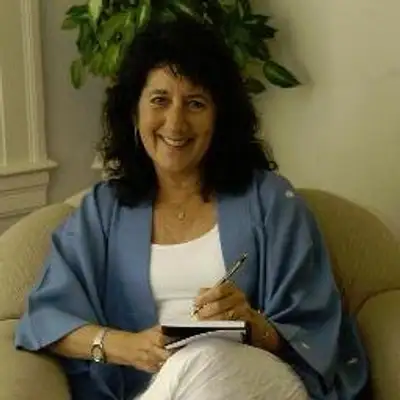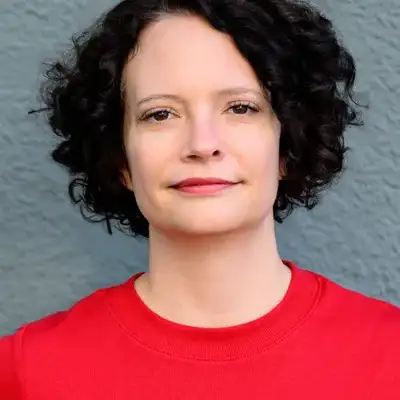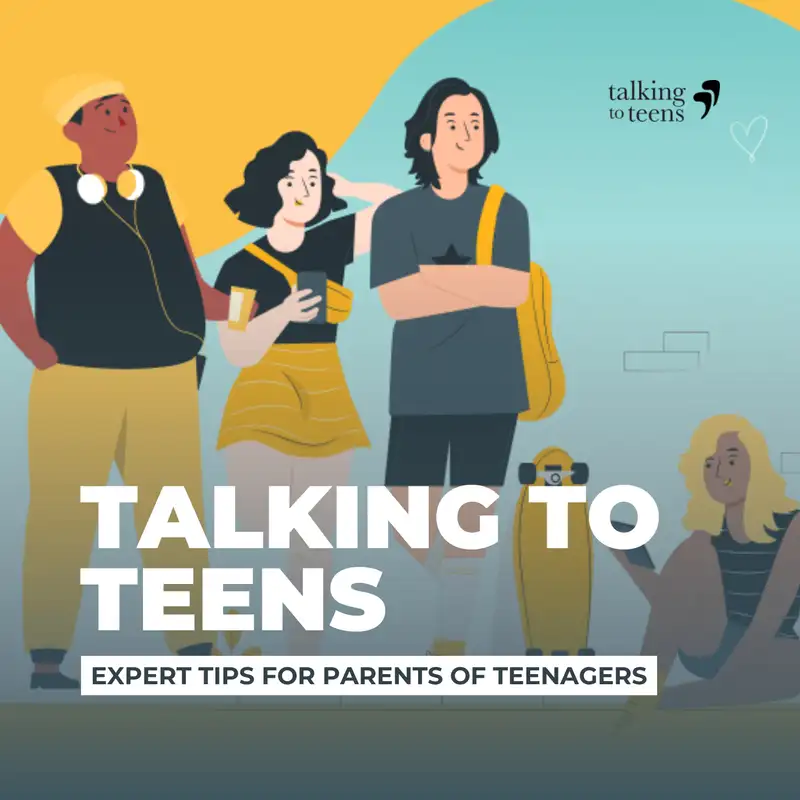Ep 302: Debunking Gender Myths for Parents
Andy Earle: You're listening to Talking to Teens, where we speak with leading experts from a variety of disciplines about the art and science of parenting teenagers. I'm your host, Andy Earle.
We're here today talking about gender misinformation.
Many of the things we might assume about transgender people or non binary people are not actually backed up by the research.
This can be harmful as parents, even if your child is cisgender.
So it's really important to set the record straight.
Today's guests are here to do just that.
We have Diane Ehrensaft returning to the show, author of numerous books on the subject and the co founder and director of mental health at the Child and Adolescent Gender Center At the university of California, San Francisco.
She is joined by Michelle Jurkiewicz, a clinical psychologist and gender specialist in Berkeley, California. The two are coauthors of the new book, Gender Explained.
Michelle and Diane, thank you so much for coming on the show today.
Michelle Jurkiewicz: Thanks for having us.
Andy Earle: So talk to me a little about the origins of this book, Gender Explained. Diane already has written a number of books on gender. What did you feel was missing? Why was there a new book needed? how did this partnership come into being?
Diane Ehrensaft: Michelle, do you want to take the lead on that one?
Michelle Jurkiewicz: Diane myself and several other colleagues co founded a group Mind the Gap.
We meet once a month, to talk about gender affirming care for children and teenagers a lot of our meetings were centered around what was happening in the media and the misinformation about gender affirming care and what families and parents were bringing us.
And I went to Diane after 1 of these meetings, and I said, Diane, somebody needs to write a book to correct some of this misinformation and help calm the anxiety. And then Diane suggested that perhaps I was going to write a book and then I don't know if you want to fill this in, Diane, shared with me at the time was that the publisher of your previous book had already reached out to you about writing a very similar book.
And so through speaking with each other we decided, let's do it together.
Diane Ehrensaft: And I will say, Andy, that when they reach out to me, I had already reached out to them about another gender book I had in mind. they said, you know what? That's a great book, but we got a better book for you.
We think this book, now you see it in Gender Explained, is much more needed right now. I never like to be bossed around. So I said, let me think about it because it wasn't the one I proposed to you. with serendipity, Michelle and I who have worked together for years had that conversation after a Mind the Gap reading, and the rest is history.
it's been a beautiful history of writing this book from two generations of psychologists, both doing the exact same work.
Andy Earle: That is so cool to hear.
that makes a lot of sense after reading the book, because so much of what you do in the book is confronting myths or common ways that transgender people are portrayed in the media or common rhetoric about how gender works What you mentioned coming up a lot in your meetings or that you guys are seeing a lot from parents, maybe having questions related to, in the book, you talk about misinformation and disinformation. What are some of the most common questions that you're having or topics that would be coming up,
Michelle Jurkiewicz: Of the there's several, but 1, the 1 that pops in my head immediately is this idea that gender affirming care is not evidence based that it is politically driven.
It's a child comes to us as providers and says, Hey, I'm transgender and I want puberty blockers and then hormones and then surgery. And we're just signing off on it without taking time to really understand developmentally and get their gender and focus and making really thoughtful decisions as a team with endocrinologists and the parents and with the child.
Andy Earle: You talk in the book about the rubber stamping myth, this idea that you're just approving whatever the kid wants, which of course doesn't make sense.
Diane Ehrensaft: And I would add to that, we are either rubber stampers, which we are not, as Michelle said, this is a very careful, deep, thoughtful process with the child as the expert, but us as their teammates.
On the other side of it is the accusation that we're wizards. you cannot make somebody transgender. That comes from within. You can't make somebody non binary.
It may be influenced by things outside yourself, but no provider has a magic wand to turn a child who is not transgender into a transgender child.
Michelle Jurkiewicz: I think some of the other big myths we were trying to address is this idea that a transgender identity or a gender diverse identity and children is not real that it's a phase.
That it's contagious those were really important things to confront because it's harmful to children to be hearing these messages that the way they identify is considered not real.
Diane Ehrensaft: I was watching you, Andy, and I was going to stop there, Yes. But I will say. That with the misinformation and disinformation that increasingly has been exposed as part of a mass political movement, not based on any medical advice or scientific evidence, we are appalled to hear people say there is no evidence.
We have both scientific evidence. And clinical evidence, which has often been the stalwart of clinical care, I think between the two of us, we've seen over 2000 children or youth. And the overwhelming evidence is that gender affirming care, when done thoughtfully, has provided tremendous boons in mental health.
We're not perfect, but I would say, overwhelmingly, the kids are not only doing fine, they're doing better. And if the society we're doing better, they do even better
Michelle Jurkiewicz: when I think to add to your point, Diane, a lot of the talk in the media when they're saying there's not this evidence.
There's also this notion that this gender affirming care just appeared yesterday. Where, as Diane is saying, there's quite a history not just that Diane and I share, but of gender affirming care in general, around the world.
Andy Earle: It's something interesting that you write about in the book is this.
idea of uncomfortable feelings happening when maybe we come across somebody who's not conforming to traditional gender norms. You talk about coming down the grocery store aisle and seeing someone who's Dressing kind of opposite to what you would think of as their gender or something that you can't place them for a while there's an uncomfortable feeling there. And then you talk about how we can allow our feelings of discomfort to be used as evidence that something is wrong with the object of our discomfort. I think that's so common in so many areas of psychology. We have uncomfortable feelings.
And so we project them onto something else and say, Oh it's because of that. It's because of you. It's because you're doing that. Instead of really examining ourselves. And I think that would cause us to latch on to some of this misinformation or disinformation that we're seeing in the media as well.
And so I wonder if there's a process that you recommend that people can go through, or how can we start to address those feelings of discomfort that we might have?
Diane Ehrensaft: I'd like to start with an example from my college days, and then I want to pass it to Michelle.
My parents sent me off to college at age 17 to a Midwestern big university, I looked like a nice suburban girl. I came home from college, mid sixties. I didn't look like a nice suburban girl anymore. My mother was appalled. She was absolutely appalled. Where was the makeup? Where was the perfect hairdo?
What's with these jeans with patches on them? And my mother projected both onto me, but also onto my university. This is what happens when you send your kids to college. Look what it does to them. in all fairness to my mother, she went through a process. she had started there, but moved very differently, particularly when my brother came home from college, looking like the male version of me.
so I want to honor her wherever she is now, post death, and saying this process works. And the basis of it is often love, I'll pass it to you, Michelle.
Michelle Jurkiewicz: In the example that you're bringing up, that was in our book, we were talking about the fast thinking and the slow thinking fast thinking being.
Our gut reactions, It's just what our brain immediately does. it's helped us to survive over the millennia. one of the things our brain does is it categorizes. it categorizes people, it categorizes things. But we have to slow down in these moments and reflect on our feelings.
And remember that when we feel something, it's not a fact. It's an experience, an internal experience that can give us information. And then if we can slow down and reflect on what we're feeling and what's going in on that moment we might.
Be able to correct some of that immediate biased or like feeling of discomfort or disgust by taking the time to reflect on ourselves. And I think that's a lot of what we're trying to do in this book encourage people to slow down and to think and reflect and to have compassion for other people.
These are other humans that are expressing themselves and it's their human right. To be able to express their gender, whichever ways are comfortable to them.
Diane Ehrensaft: and it's in the book when we talk about gender ghosts and gender angels, that we all have internalized some of those quick thinking, reactive responses.
if any one of us says, oh, we've never had them, stop and take a look then bring them to the light of day and match them against what we call the gender angels, which is this new gender literacy that gender doesn't come in just two boxes. And that it's actually creative and expensive.
To give every person the opportunity to paint their own gender canvas, and I know that some people think that's travesty, if not blasphemy of what I just said. I just wanted to tell you a story from 1 of the youngest people. We might be seeing. And this was a 4 year old. this was a 4 year old who knew at age 3 that somebody made a mistake.
They were not a boy. They were a girl and they socially transitioned. they got picked up from daycare by their mom in a small rural community where there was only one choice of daycare centers run by a church. And this little person, age four, said, Mommy, we learned. in school today that God created all children in his image.
So God's transgender.
Andy Earle: I love that. I think what we're talking about here is so important. You talk about the angels and the ghosts and also about microaggressions a little bit. And I think that becoming more aware of our own reactions and our own internalized ideas about gender are so important because we're subtly sending messages to our kids all the time without even realizing it.
they see the ways we're reacting to messages coming at us throughout our day. And that's communicating to them. What's okay with us what they can talk to us about or how we're going to react when they come to us with something. And the more we can recognize those things in ourself and work on them or become more comfortable with them.
We talked On the previous episode about gender dysphoria, you talk in this book about social gender dysphoria. What is the difference?
Diane Ehrensaft: I made it up. It's a completely made up diagnosis. I confess it was in response to reading all this data about children's gender dysphoria and knowing at the same time that the evidence is overwhelmingly in the direction of if children get social support, their dysphoria goes down.
It doesn't necessarily disappear, but it goes down. And when they don't get that kind of support, This dysphoria either stays the same or rises I thought, Oh that makes it simple. people have these internal biases that then turn into legislative actions in many states in this country right now.
Let's treat as our patient, social gender dysphoria. Let's get out of our offices. and do the best we can to help remedy that. make the environment a safer place for people of all genders, all sexualities, and it really is part of equality and we're way far away from that when we started the gender rights movement.
Affirmative model many years ago. At first we thought we were a rocket ship puttering. We'll never get off the ground. then it looked like we were soaring. now it looks like there's all kinds of arrows trying to knock us down, but we're going to stay up there.
Michelle Jurkiewicz: It was so important to include the social gender dysphoria.
I love this term that Diane created. Earlier on a lot of times with kids, they were very clear that they wanted a different body, or at least that's what they were talking about. And that's not necessarily what we're seeing a lot of the time. We're seeing more young people who are not necessarily disliking their body or wanting it to be different until they're receiving messages from their communities.
That in order to be legitimate. They have to make these changes in their body. I think historically, we've always located gender dysphoria as discomfort with one's body internally rather than as a result of the external reactions,
Andy Earle: it doesn't just happen internally. It's because of all the constant feedback you're getting from everyone around you that you're not fitting into one of the boxes.
Exactly.
Diane Ehrensaft: I think until we can break down. Which is now a social equation, not a scientific equation, that penis equals boy, vagina equals girl, and change it to the majority of penises will identify as boys, but some girls, the majority of people who have vaginas will identify as girls, but some are boys.
Begin there.
Andy Earle: And some are neither.
Diane Ehrensaft: I was gonna say,
Andy Earle: and
Diane Ehrensaft: some are everything
Andy Earle: The gender smoothies. You talk in the book about Barbie, and you make a point that Barbie. Is although it's really fits into kind of female stereotypes. In a lot of ways, it was actually early evidence of the gender affirmative model in action.
What do you mean by that?
Diane Ehrensaft: What I mean by that is, was like a magnet for many boys who were working out either their gender. Or later their sexuality to be Barbie fans And when they had them, it was not so much that they wanted to hook up with them, but they wanted to check out their style and everything about them to see what might work for them.
They were finding a mirror in the same Barbie dolls that feminist mothers like myself didn't want our daughters to find as mirrors. And we overlooked the cultural meaning and the multiple meanings of a Barbie doll. When I read all these accounts of more of them gay men and the meaning for Barbie for them in their childhood, I thought, we really need to think about how we're defining gender expansiveness for people of all genders and sexualities or evolving sexualities.
And now a lot of boys and men wear pink because of the Barbie movie.
Andy Earle: You talk in the book about rapid onset gender dysphoria and you disprove the existence of this idea. Why did you think that was so important to talk about?
Michelle Jurkiewicz: This fake diagnosis has been so much in the media. there's been magazine and newspaper articles, but there's even been books written around the idea that this is a real diagnosis and how we need to treat it and what we need to do.
besides the fact that it's not true, and it's not based in any kind of scientific evidence. It's also quite harmful for.
Families and the young people who are saying this we have some scientific research that has been done to show that it doesn't exist that we're not seeing drastic differences between somebody who comes out as a child versus a teenager. In terms of how their gender dysphoria is looking or in terms of their mental health.
Andy Earle: it's really this idea that a teenager. Could just all of a sudden decide, I'm not happy with my gender. I want to change it. Or maybe they're not fitting in or something and they latch onto this thing.
Michelle Jurkiewicz: Exactly, especially it's for designated female at birth.
I don't believe it's ever been used to reference a young person who is designated male at birth because the idea behind it is that girls in our society are so susceptible and they're just social media and that Peer influence. they can't know themselves.
And so they just go along with whatever or they have internalized misogyny. And so they're wanting to be the more powerful gender and this is how they're going about it. Which is ridiculous.
Diane Ehrensaft: It's a combination of sexism and patriarchy.
Michelle Jurkiewicz: Exactly.
Diane Ehrensaft: Yes. Just merged and it does tremendous disservice for the young people of the world.
exploring gender and designated female at birth or male at birth in terms of their own identity formation in adolescence. It doesn't belong to anybody else, but them. I do research. I read a lot. My best instructors have been youth.
If I've learned anything from gender, it's from listening and I still have a lot to learn and they're putting it all together. I think they're the ones leading this gender explosion revolution we're following to make sure they have a good life.
Michelle Jurkiewicz: I 100 percent agree with that.
Diane Ehrensaft: And that's where I'll be busted again.
I made up another diagnosis.
And that was rapid onset parental discovery. Because a number of the kids who first articulate particularly to their parents, I have something to tell you about my gender, often done by text from the next room, have known for maybe up to 8 years or more. And it's been germinating or there, and just not exposed or disclosed
It's really helpful to know that it may not be sudden what sudden is you finding out and you will need some supports because that's a showstopper.
Andy Earle: It feels sudden to you, but it's also maybe because you've been overlooking some signs, or we have this story about who our child is in our head and it's really hard to see things in a different way.
Diane Ehrensaft: And I think that's one of the most important messages that Michelle wanted to get out to parents about children of all genders, that in the long run, It's not about your dreams. It's about their dreams. Even though you can know the sex of your child before birth and begin dreaming, you may have to switch the channel on the dream.
Andy Earle: Wow.
A lot of really interesting stuff in this book. looking back through history and seeing how things have evolved and how we think about gender and how we talk about gender. as much as we're in this space of misinformation and disinformation, it's also encouraging to see how much things have changed and where we seem to be heading.
Diane Ehrensaft: the train left the station.
Andy Earle: Michelle and Diane, thank you so much for coming on the show today. It's been an honor and a fascinating conversation
Diane Ehrensaft: And thank you so much for your questions. It made us think. About the book again. Yes. Thank you so
Andy Earle: I highly encourage people to check out a copy of Gender Explained, a new understanding of identity in a gender creative world.
Where can people go to find out more about what you are both doing? Maybe follow updates from you or learn about future projects that you might be involved in.
Michelle Jurkiewicz: We both have websites, they're listed on the book. So that's a fantastic way and you can reach us through our websites. I guess we do post on social media. I can't quite remember my Instagram right now because I don't use it except for this book. I'm new to Instagram.
Andy Earle: We'll put those in the show notes so everyone can see where to get ahold of you.
Yeah. I see you both right here. stillwaterpsychotherapy. com and dianeehrensaft. com yes. Excellent. Thanks again for coming on the show.
Diane Ehrensaft: And thanks for inviting us.
Andy Earle: always a pleasure.
Diane Ehrensaft: Great to see you again, Andy.
Andy Earle: We're here with Diane Ehrensaft and Michelle Jurkiewicz talking about gender misinformation. And we're not done yet. Here's a look at what's coming up in the second half of the show.
Why does a child have to change their name to authenticate their gender? Why can't Susie just be a person's name rather than a girl's name?
Diane Ehrensaft: Names are signifiers. for a child who's been misgendered, with microaggressions against them, a change in name can really reduce the gender stress dramatically.
The more you can build a family tapestry where everybody feels in harmony, rather than there being a cacophony and people in conflict with each other, the better.
Michelle Jurkiewicz: The critical thing is to really be listening to help your child feel as though you are trying to understand and that you're learning so you can better understand their experience
We're not saying that there's wrong ways of doing gender.
We're actually saying that they're all correct, depending on what somebody feels for themselves.
Andy Earle: Want to hear the full interview? Sign up for a subscription today. It's completely affordable and your membership supports the work we do here at Talking to Teens. You can now sign up through Apple Podcasts. Thanks for listening and we'll see you next time.
Creators and Guests




